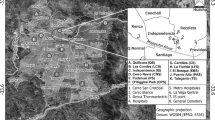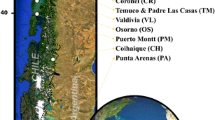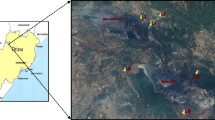Abstract
Local physical characteristics (e.g., meteorology and topography) associate to particle concentrations are important to evaluate air quality in a region. Meteorology and topography affect air pollutant dispersions. This study used statistics tools (PCA, HCA, Kruskal–Wallis, Mann–Whitney’s test and others) to a better understanding of the relationship between fine particulate matter (PM2.5) levels and seasons, meteorological conditions and air basins. To our knowledge, it is one of the few studies performed in Latin America involving all parameters together. PM2.5 samples were collected in six sampling sites with different emission sources (industrial, vehicular, soil dust) in Rio de Janeiro, Brazil. The PM2.5 daily concentrations ranged from 1 to 61 µg m−3, with averages higher than the annual limit (15 µg m−3) for some of the sites. The results of the statistics evaluation showed that PM2.5 concentrations were not influenced by seasonality. Furthermore, air basins defined previously were not confirmed, because some sites presented similar emission sources. Therefore, new redefinitions of air basins need to be done, once they are important to air quality management.
Similar content being viewed by others
References
ASTM D4096-91 (2009) Standard test method for determination of total suspended particulate matter in the atmosphere (high-volume sampler method). ASTM International, West Conshohocken, pp 1–9
EPA (Environmental Protection Agency) (2006) 40 CFR Part 50, Rules and regulations. national ambient air quality standards for particulate matter; Final Rule, vol 71. Federal Register
FEEMA (Fundação Estadual de Engenharia Ambiental) (2004) Inventário de Fontes Emissoras de Poluentes Atmosféricos da Região Metropolitana do Rio de Janeiro, Rio de Janeiro, pp 7–15
FEEMA (Fundação Estadual de Engenharia Ambiental) (2006) Relatório Anual da Qualidade do Ar do Estado do Rio de Janeiro—2006, Rio de Janeiro, pp 5–7
Godoy MLDP, Godoy JM, Roldão LA, Soluri DS, Donagemmab RA (2009) Coarse and fine aerosol source apportionment in Rio de Janeiro, Brazil. Atmos Environ 43:2366–2374
Grubbs FE (1969) Procedures for detecting outlying observations in samples, vol 11. Taylor and Francis Group, New York, pp 1–21
Heintzenberg J (1989) Fine particles in the global troposphere—a review. Tellus B 41B:149–160
INEA (Rio de Janeiro Environment Institute) (2013) Air quality report 2013, annual base 2010/2011. Rio de Janeiro, Brazil
Kaiser HF (1960) The application of electronic computers to factor analysis. Educ Psychol Measur 20:141–151
Kampa M, Castanhas E (2008) Human health effects of air pollution. Environ Pollu 151:362–367
Marcazzan GM, Vaccaro S, Valli G, Vecchi R (2001) Characterisation of PM10 and PM2.5 particulate matter in the ambient air of Milan (Italy). Atmos Environ 35:4639–4650
Masiol M, Squizzato S, Rampazzo G, Pavoni B (2014) Source apportionment of PM2.5 at multiple sites in Venice (Italy): spatial variability and the role of weather. Atmos Environ 98:78–88
NBR 13412 (1995) Material particulado em suspensão na atmosfera. Determinação da concentração de partículas inaláveis pelo método do amostrador de grande volume acoplado a um separador inercial de partículas. Associação Brasileira de Normas Técnicas, Rio de Janeiro, pp 1–8
Parrish DD, Singh HB, Molina L, Madronich S (2011) Air quality progress in North American megacities: a review. Atmos Environ 45:7015–7025
Pimentel LCG, Marton E, da Silva MS, Jourdan P (2014) Characterization of surface wind regime in the metropolitan area of Rio de Janeiro. Eng Sanit Ambient 19:121–132
Pires DO (2005) Inventário de Emissões Atmosféricas de Fontes Estacionárias e sua Contribuição para Poluição do Ar na Região Metropolitana do Rio de Janeiro, Tese (Mestrado)—COPPE/UFRJ, Rio de Janeiro, pp 188–189
R Development Core Team (2011) R: a language and environment for statistical computing. R Foundation for Statistical Computing, Vienna (ISBN 3-900051-07-0). http://www.R-project.org/
Rodriguez-Cotto R, Martínez MGO, Ramírez ER, Mateus VL, Amaral BS, Jimenez-Velez B, Gioda A (2014) Particle pollution in Rio de Janeiro, Brazil: increase and decrease of pro-inflammatory cytokines IL-6 and IL-8 in human lung cells. Environ Pollut 194:112–120
Shaka H, Saliba NA (2004) Concentration measurements and chemical composition of PM10–2.5 and PM2.5 at a coastal site in Beirut, Lebanon. Atmos Environ 38:523–531
Shapiro SS, Wilk MB (1965) An analysis of variance test for normality (complete sample). Biometrika (Great Britain) 52(3):591–611
Soluri DS, Godoy MLDP, Godoy JM, Roldão LA (2007) Multi-site PM2.5 and PM2.5–10 aerosol source apportionment in Rio de Janeiro, Brazil. J Braz Chem Soc 18:838–845
Swietlicki E, Hansson HC, Svenningsson K, Massling A, Mcfiggans G, Mcmurry PH, Petäjä T, Tunved P, Gysel M, Topping D, Weingartner E, Baltensperger U, Rissler J, Wiedensohler A, Kulmala M (2008) Hygroscopic properties of submicrometer atmospheric aerosol particles measured with H-TDMA instruments in various environments—a review. Tellus B 60:432–469
US EPA (United States Environmental Protection Agency) (1999), EPA/625/R-96/010a, Method IO-2.1—sampling of ambient air for total suspended particulate matter (SPM) and PM10 using high volume (HV) sampler. Cincinnati 2.1-1–2.1-19
Voutsa D, Samara C (2002) Labile and bioaccessibile fractions of heavy metals in the airborne particulate matter from urban and industrial areas. Atmos Environ 36:3583–3590
Acknowledgements
The authors are grateful to the Environment Institute of Rio de Janeiro State (INEA) for providing PM2.5 concentration and meteorological data; and to the Foundation Agencies Support Research in Rio de Janeiro State (FAPERJ), National Council of Scientific and Technological Development (CNPq) and Coordination for the Improvement of Higher Education Personnel (CAPES) for financial support for the research. A. S. L thanks to Programa Prociência, UERJ.
Author information
Authors and Affiliations
Corresponding author
Additional information
Responsible Editor: S. T. Castelli.
Electronic supplementary material
Below is the link to the electronic supplementary material.
Rights and permissions
About this article
Cite this article
Ventura, L.M.B., de Oliveira Pinto, F., Soares, L.M. et al. Evaluation of air quality in a megacity using statistics tools. Meteorol Atmos Phys 130, 361–370 (2018). https://doi.org/10.1007/s00703-017-0517-x
Received:
Accepted:
Published:
Issue Date:
DOI: https://doi.org/10.1007/s00703-017-0517-x









